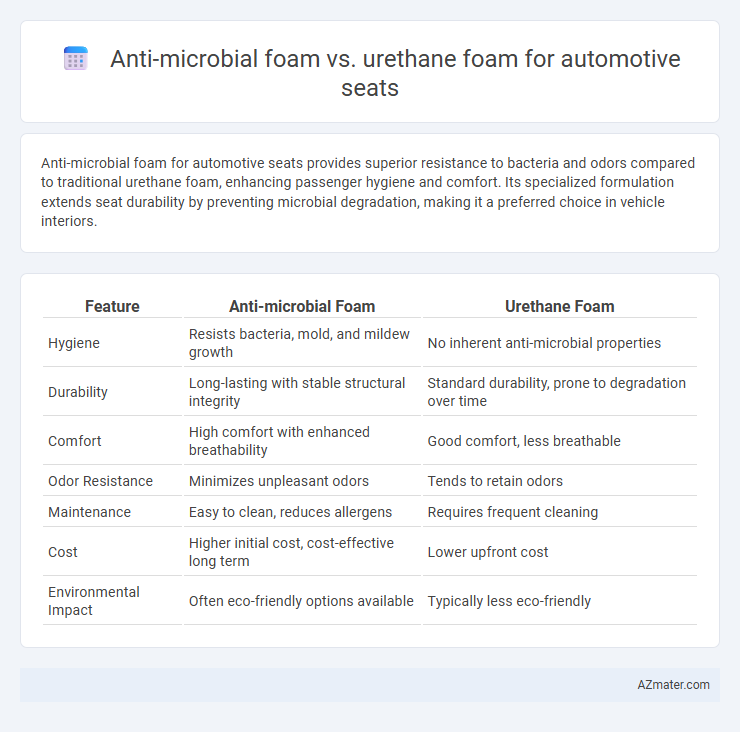Anti-microbial foam for automotive seats provides superior resistance to bacteria and odors compared to traditional urethane foam, enhancing passenger hygiene and comfort. Its specialized formulation extends seat durability by preventing microbial degradation, making it a preferred choice in vehicle interiors.
Table of Comparison
| Feature | Anti-microbial Foam | Urethane Foam |
|---|---|---|
| Hygiene | Resists bacteria, mold, and mildew growth | No inherent anti-microbial properties |
| Durability | Long-lasting with stable structural integrity | Standard durability, prone to degradation over time |
| Comfort | High comfort with enhanced breathability | Good comfort, less breathable |
| Odor Resistance | Minimizes unpleasant odors | Tends to retain odors |
| Maintenance | Easy to clean, reduces allergens | Requires frequent cleaning |
| Cost | Higher initial cost, cost-effective long term | Lower upfront cost |
| Environmental Impact | Often eco-friendly options available | Typically less eco-friendly |
Introduction to Automotive Seat Foam Materials
Automotive seat foam materials primarily include anti-microbial foam and urethane foam, both designed to offer comfort and durability. Anti-microbial foam is engineered with additives that inhibit bacteria, mold, and mildew growth, enhancing hygiene and longevity in vehicle interiors. Urethane foam, widely used for its excellent cushioning properties and resilience, provides superior support and impact absorption in automotive seating applications.
Overview of Urethane Foam in Car Seating
Urethane foam is widely used in automotive seating due to its excellent comfort, durability, and cost-effectiveness. This flexible foam provides optimal support and cushioning, enhancing driver and passenger experience while maintaining shape over time. Its ability to be engineered with varying densities allows customization for different seat components, balancing firmness and softness efficiently.
What is Anti-Microbial Foam?
Anti-microbial foam used in automotive seats incorporates agents that inhibit the growth of bacteria, mold, and mildew, enhancing hygiene and durability. Unlike standard urethane foam, which primarily offers cushioning and support, anti-microbial foam actively reduces odor and potential health risks associated with microbial contamination. This advanced foam technology extends seat longevity and maintains a cleaner interior environment in vehicles.
Key Differences Between Anti-Microbial and Urethane Foams
Anti-microbial foam in automotive seats contains additives that inhibit the growth of bacteria, mold, and mildew, enhancing hygiene and occupant comfort, whereas urethane foam primarily provides cushioning and structural support without inherent antimicrobial properties. Anti-microbial foams typically feature enhanced durability against odors and microbial degradation, making them suitable for high-use environments, while urethane foams offer customizable firmness and resilience but require additional treatments for microbial resistance. Selection depends on the priority of hygiene versus mechanical performance, with anti-microbial foam excelling in health benefits and urethane foam excelling in comfort and adaptability.
Health and Hygiene Benefits: Anti-Microbial Foam
Anti-microbial foam in automotive seats significantly reduces the growth of bacteria, mold, and fungi, enhancing passenger health by minimizing allergens and unpleasant odors. This foam type prevents the accumulation of harmful microbes that can cause respiratory issues and skin irritations during prolonged vehicle use. Compared to urethane foam, anti-microbial foam offers superior hygiene benefits by maintaining a cleaner, safer seat environment for drivers and passengers.
Durability and Longevity Comparison
Anti-microbial foam for automotive seats offers enhanced resistance to mold, bacteria, and odor, significantly extending the seat's hygiene and lifespan compared to traditional urethane foam. Urethane foam, while providing excellent cushioning and structural support, tends to degrade faster under exposure to moisture and microbial activity, leading to reduced durability over time. The incorporation of anti-microbial agents in foam formulations improves longevity by preventing microbial breakdown and maintaining foam integrity in demanding automotive environments.
Comfort and Support: User Experience
Anti-microbial foam in automotive seats offers enhanced comfort by reducing odors and bacterial growth, contributing to a fresher seating environment during long drives. Urethane foam provides superior support and durability, maintaining seat shape and firmness over extended use, which benefits posture and reduces fatigue. Users often report a balanced comfort experience with anti-microbial foam while valuing urethane foam's structural support for overall ride quality.
Cost Considerations for Manufacturers
Anti-microbial foam for automotive seats typically incurs higher initial costs due to specialized antimicrobial agents and manufacturing processes compared to standard urethane foam. Urethane foam offers more cost-efficient production and material expenses but may lead to increased maintenance or replacement costs over time due to microbial growth concerns. Manufacturers must balance upfront material costs with long-term durability and hygiene benefits when selecting between anti-microbial and urethane foams.
Environmental Impact of Both Foam Types
Anti-microbial foam used in automotive seats often contains biocides that can impact aquatic ecosystems when disposed of improperly, whereas urethane foam production involves isocyanates and polyols contributing to VOC emissions and global warming potential. Recyclability of urethane foam remains limited, leading to significant landfill accumulation, while some anti-microbial foams are engineered for better biodegradability, reducing long-term environmental footprint. Life cycle assessments indicate that selecting foam types with lower toxic chemical content and enhanced end-of-life disposal options plays a crucial role in minimizing overall environmental impact in automotive applications.
Future Trends in Automotive Seat Foam Technologies
Anti-microbial foam in automotive seats offers advanced bacteria resistance and odor control, enhancing passenger hygiene and comfort compared to traditional urethane foam. Future trends emphasize integrating smart materials with anti-microbial properties that improve durability while supporting sustainability through bio-based and recyclable components. Innovations also focus on optimizing foam formulations to reduce weight and increase energy absorption, contributing to enhanced safety and fuel efficiency in next-generation vehicles.

Infographic: Anti-microbial foam vs Urethane foam for Automotive seat
 azmater.com
azmater.com